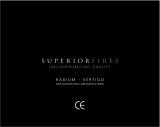PREPARING THE APPLIANCE
1. Firstly remove the two retaining
screws on each side of the upper grille
and (X-Fire 1000 only) remove the
grille from the outer casing.
2. Remove the two retaining wing
nuts from the retaining studs that
protrude into the lower part of the
main firebox as shown.
The control knob is located on the
lower right hand side of the outer cas-
ing, and is mounted in an indicator
bracket, which has a metallic indica-
tion ‘pip’. Both the knob and the indi-
cator bracket should be removed as
follows;
3. Remove the retaining pin from the
gas valve spindle and withdraw the
control knob and the spindle exten-
sion from the right hand side of the
appliance.
4. Remove the four retaining screws
and the indicator bracket. The firebox
may now be detached from the outer
casing.
FIXING THE
APPLIANCE
It is recommended that the burner
height, where possible, should be
between 1.0 and 1.2 metres from the
floor. This will give the best viewing
position.
After selecting the final mounting
position of the appliance, taking into
account the site requirements as
specified in section 4 of these instruc-
tions, the integrity of the wall, and the
feasibility of the proposed supply
pipe routing, the firebox of the appli-
ance may be secured to the wall.
Due to the weight of the front facia, it is possible to fix the outer casing to the wall in up to nine (X-Fire 1000 mod-
els), or fifteen (X-Fire widescreen models) positions, depending on the strength/condition of the wall. If in doubt
always use extra fixings! Use a spirit level to ensure that the outer casing is level at all times during installation.
If the appliance is to be mounted on the inner leaf of a conventional cavity wall, or a solid wall, drill four holes using
a 6.5mm masonry bit, to a depth of 39mm. Insert the fibre wall plugs provided. If the appliance is to be mounted
on a dry lined wall or a timber framed construction wall then special cavity screw fixings will be required which are
not supplied with this product. These should be constructed from metal and not plastic.
Insert the screws into two of the upper holes, leaving 5mm protruding from the wall. Temporarily hang the outer
casing on the wall, and mark any additional fixing points as required. If the appliance is to be fitted to a lightly
coloured wall, it is advantageous to paint this wall area with black or dark paint in the vicinity of the lower rectan-
gular slots on the outer casing. This will mask the wall when viewed from the front of the appliance. Ensure paint is
fully dry before mounting the appliance. Use the outer casing as a template to mark this area on the wall. Remove
the outer casing from the wall and drill holes for the additional fixing points as required. Insert either wall plugs or
cavity screw fixings as required. Re-position the outer casing on the wall and using a spirit level to check the cas-
ing is square and level, tighten all of the fixing screws fully.
Now, with the outer casing fixed to the wall, the main firebox can be secured in position.
The firebox is held on the outer casing using four studs and two normal nuts (upper fix-
ings) and two wing nuts (lower fixings). Make sure that the upper nuts are un-screwed
approximately one turn from the fully tightened position in order to create a 2mm gap
as shown. The firebox may now be hung onto the top studs, and then pushed onto the
lower studs so that the lower studs protrude through the lower fixing holes in the back
panel of the firebox. Tighten the lower fixing wing nuts on to the lower fixing studs fully.
Next, re-fit the grille, (X-fire 1000 models only) the indicator bracket and the control
knob and spindle, and secure in position using the correct fixing screws (re-fitting is the opposite of removal as
detailed in section 7.0 of these instructions).
5
1. Remove the Grille.
Note: This design of grille
not fitted to widescreen
model
2. Remove retaining
wing nuts
3. Remove
spindle
retaining pin
4. Remove control indicator bracket and control knob
2mm
7.0
7.1
Note : X-Fire 1000
shown as example
5. Widescreen
models : Remove
two self-tapping
screws from the
Left hand side of
the outer casing
and one from the
right hand side.
5.




















